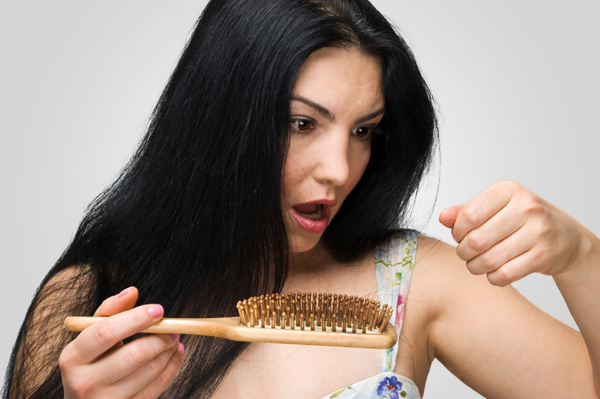Hair cycle and Hair Loss Explained ( Toppik Malaysia )

Hair grows from the follicle, or root, underneath the skin. The hair is ‘fed’ by blood vessels at the base of the follicle, which give it the nourishment it needs to grow. Between starting to grow and falling out years later, each hair passes through four stages: anagen, catagen, telogen and exogen. Every hair is at a different stage of the growth cycle.
Over time, the length of the anagen stage decreases. Therefore, the hair may become weaker and thinner after each cycle. That’s why it’s important to ensure your diet is rich in specific nutrients to maintain normal, healthy hair growth.
Anagen (Growing Phase)
The growing phase lasts two to seven years and determines the length of our hair.
Catagen (Transition Phase)
This is the transitional stage that lasts about ten days. The hair follicle shrinks and detaches from the dermal papilla.
Telogen (Resting Phase)
This is the resting phase which lasts around three months. Around 10-15 percent of hairs are in this phase. Whilst the old hair is resting, a new hair begins the growth phase.
Exogen (New Hair Phase)
This is part of the resting phase where the old hair sheds and a new hair continues to grow. Approximately 50 to 150 hairs can fall out daily, this is considered to be normal hair shedding.
If hairs enter the resting phase too early, excess shedding and noticeable thinning can occur.

Common Hairloss Causes
GENETICS
A common family predisposition involves natural, age-related hormonal changes that can trigger hair loss. This is caused by the conversion oftestosteroneinto the toxin Dihydrotestosterone (DHT) and can be inherited from either your mother or your father.
STRESS AND TRAUMA
Stress can produce increased levels oftestosterone, which converts toDHTand interrupts the hair’s growth cycle. Stress also constricts blood supply through the capillaries, restricting oxygen and nutrient uptake and vitamins to the hair follicle.
A common family predisposition involves natural, age-related hormonal changes that can trigger hair loss. This is caused by the conversion oftestosteroneinto the toxin Dihydrotestosterone (DHT) and can be inherited from either your mother or your father.
STRESS AND TRAUMA
Stress can produce increased levels oftestosterone, which converts toDHTand interrupts the hair’s growth cycle. Stress also constricts blood supply through the capillaries, restricting oxygen and nutrient uptake and vitamins to the hair follicle.
NUTRITION AND DIET
What you eat can play a significant role in hair thinning. A high consumption of animal fats, rapid weight loss and liquidproteindiets can result in a lack of amino acids,biotin,iron,proteinandzinc— all of which are essential for healthy-looking hair.
What you eat can play a significant role in hair thinning. A high consumption of animal fats, rapid weight loss and liquidproteindiets can result in a lack of amino acids,biotin,iron,proteinandzinc— all of which are essential for healthy-looking hair.
HEALTH ISSUES
Several underlying health issues can cause hair thinning, including a malfunctioning of the hormone-producingthyroidgland and the natural hormonal changes women experience after pregnancy and during the menopause.
Several underlying health issues can cause hair thinning, including a malfunctioning of the hormone-producingthyroidgland and the natural hormonal changes women experience after pregnancy and during the menopause.
ENVIRONMENTAL FACTORS
Air and water pollutants,chlorine, metals and minerals may be left on the scalp and hair as we wash with water every day, contributing to thinning. Pollutants such as pseudo-estrogens and toxins from within our bodies are also a factor.
Air and water pollutants,chlorine, metals and minerals may be left on the scalp and hair as we wash with water every day, contributing to thinning. Pollutants such as pseudo-estrogens and toxins from within our bodies are also a factor.
MEDICATION
The hair follicle is incredibly sensitive to changes in the body. Any hormone therapy (including birth control) can contribute to hair thinning, as can steroids, specific chemotherapies, and medication for blood pressure, diabetes, heart disease and acne.
The hair follicle is incredibly sensitive to changes in the body. Any hormone therapy (including birth control) can contribute to hair thinning, as can steroids, specific chemotherapies, and medication for blood pressure, diabetes, heart disease and acne.
Genetics Hairloss Causes
The causes of Alopecia Areata are not fully understood. Alopecia Areata
is considered to be an auto-immune condition in which the immune system
of the body (which protects the body from bacteria, viruses, allergens,
etc.) mistakenly attacks the hair follicles and destroys them. This
leads to hair loss in the affected area. This abnormal behavior of the
immune system is understood to be guided, influenced and triggered by
multiple factors.

The exact cause, why hair follicles undergo this kind of destruction, is not known but a genetic component to this is suspected. Family history of Alopecia Areata or any of the other auto-immune diseases (such as hypothyroid, diabetes, cancer, ulcerative colitis, rheumatoid arthritis, etc.) is often seen in many cases, suggesting a role of genetic element. In addition to the genetic predisposition, certain triggering factors may bring on the onset of this condition. Prolonged underlying stress often predisposes some patients to develop auto-immune process leading to Alopecia Areata. However, stress may not be the cause in every case. Alopecia Areata treatment has to take into account the underlying causes.
No comments:
Post a Comment